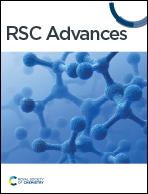Abstract
A starting thiacalix[4]arene can be easily transformed into oxidized phenoxathiin-based macrocycles 9 and 9′, representing an unusual structural motif in calixarene chemistry. The presence of electron-withdrawing groups (SO2, SO) and the considerable internal strain caused by the condensed heterocyclic moiety render these molecules susceptible to nucleophilic attack. The reaction with various organolithium reagents provides a number of different products resulting from the cleavage of either the calixarene skeleton or the phenoxathiin group or both ways simultaneously. This enables the preparation of thiacalixarene analogues with unusual structural features, including systems containing a biphenyl fragment as a part of the macrocyclic skeleton. The above-described transformations, unparalleled in classical calixarene chemistry, clearly demonstrate the synthetic potential of this thiacalixarene subgroup.



 Please wait while we load your content...
Please wait while we load your content...